Muji
Ryohin Keikaku Co., Ltd. (株式会社良品計画, Kabushiki-gaisha Ryōhin Keikaku) (TYO: 7453), or Muji (無印良品, Mujirushi Ryōhin) is a Japanese retail company which sells a wide variety of household and consumer goods. Muji's design philosophy is minimalist, and it places an emphasis on recycling, reducing production and packaging waste, and a no-logo or "no-brand" policy. The name Muji is derived from the first part of Mujirushi Ryōhin, translated as No-Brand Quality Goods on Muji's European website.[3]
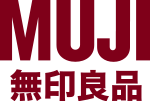 | |
Native name | 無印良品 |
|---|---|
Romanized name | Mujirushi Ryōhin |
| Public (TYO: 7453) | |
| ISIN | JP3976300008 |
| Industry | Manufacturing, retail, cafe |
| Founded | 1980 |
| Headquarters | , |
Number of locations | 656 (2016)[1] |
Key people | |
| Products | Household goods Kitchen utensil Fashion Stationery Electronics Home appliances Cosmetics Food Furniture |
| Services | Residential Architectural design[2] |
| Divisions | Dabbey Muji, Café Muji, Meal Muji, Muji Campsite, florist and home furnishing; |
| Website | muji muji |
Products and businesses
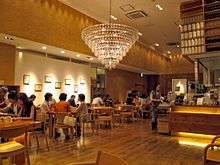
Muji started with only 40 products in the 1980s. Some of their products include pens, pencils, notebooks, storage units, apparel, kitchen appliances, food items, and household care products. Muji has also created an automobile. Muji storefronts such as the one in New York are large and stocked with nearly every single product available. The primary business also includes Café Muji, Meal Muji, Muji Campsite, florist and home furnishing; the company has also engaged in architectural projects such as Muji House.
By the end of the 2000s, Muji was selling more than 7,000 different products. It is positioned as a "reasonably priced" brand, keeping the retail prices of products "lower than usual" by the materials it selects, streamlining its manufacturing processes, and minimising packaging.[4]
Muji has opened hotels in Shenzhen, Beijing, and Ginza, Tokyo.[5]
History
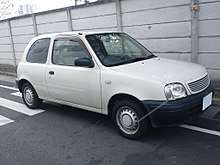
Mujirushi (no-brand) Ryōhin (quality goods) began as a product brand of the supermarket chain The Seiyu, Ltd. in December 1980. The Mujirushi Ryōhin product range was developed to offer affordable quality products and were marketed using the slogan “Lower priced for a reason.” Products were wrapped in clear cellophane, plain brown paper labels and red writing. Mujirushi Ryōhin's drive to cut retail prices for consumers saw the company cutting waste by, for example, selling U-shaped spaghetti, the left-over part that is cut off to sell straight spaghetti.[6][7]
In 1983, the first directly operated Mujirushi Ryōhin store opened. In 1985, Mujirushi Ryōhin started overseas production and procurement, started to place direct factory orders in 1986, and in 1987 Muji started to develop material globally.
In 1989, Ryohin Keikaku Ltd became the manufacturer and retailer for all Mujirushi Ryōhin products and operations, including planning, development, production, distribution and sale.
In 1991, Mujirushi Ryōhin opened its first international store in London.
In 1995, shares in “Muji Tsunan Campsite” were registered as over-the-counter shares of Japan Securities Dealers Association. In 1998, Ryōhin Keikaku listed on the second section of the Tokyo Stock Exchange. From 2001 onwards, it was listed on the first section.[8][9] In April 2001 they issued the Muji Car 1000 (ムジ・カー 1000), a limited release of 1,000 badgeless and decontented Nissan Marches, only available online. Intended as an exercise to test their online marketing systems it was developed together with Nissan. The spartanly equipped little car (with the rear seat upholstered in vinyl, for instance) was only offered in "marble white".[10]
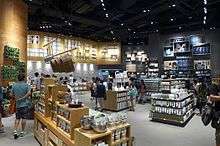
The brand name "Muji" appears to have been used since around 1999.[9]
Countries of operation
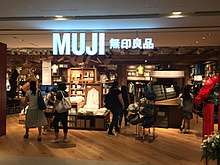

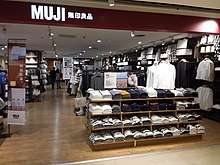
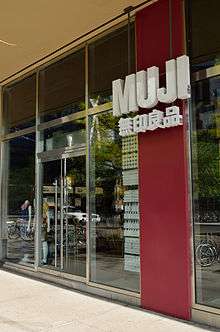
In Japan, Ryohin Keikaku has 328 directly-operated stores, and supplies 124 outlets, as of August 2017.[11] Ryohin Keikaku has three factory outlets at Osaka, Gotenba and Fukuoka.[12]
There are 505[3] International retail outlets as of November 2019, which include UK (12), Finland (1), France (7), Italy (8), Germany (7), Ireland (1), Sweden (1), Spain (6), Turkey (2), Poland (1), Portugal (1), United States (17), Canada (8), Hong Kong (19), Singapore (11), Malaysia (7), South Korea (30), Mainland China (264), Taiwan (51), Thailand (17), Australia (5), Indonesia (6), Philippines (5), Bahrain (3), Kuwait (2), Qatar (2), Saudi Arabia (4), UAE (5), Oman (1), India (4), Switzerland (1).[11][13][14]
American Operations
Muji opened its first American store on November 16, 2007, in SoHo, Manhattan. [15] In 2008, it opened two more stores in Manhattan: one in Times Square[16], and one in Chelsea.[17]
On November 30, 2012, it opened its first store on the West Coast in South of Market, San Francisco.[18]
In New York City, Muji supplies products to a design store at the Museum of Modern Art and maintains a flagship store.[12] As of November 2018, there are 5 stores in Manhattan, one in northern New Jersey, one in Boston, 6 stores in California, and one in Portland.[19] A small branch is at JFK International Airport,[19] and another location in Williamsburg, Brooklyn, has been announced, but is yet to open.[20]
In July 2020, Muji USA filed for Chapter 11 bankruptcy, citing shutdowns from the COVID-19 pandemic.[21]
No-brand branding
Muji's no-brand strategy (generic brand) means that little money is spent on advertisement or classical marketing, and Muji's success is attributed to word of mouth, a simple shopping experience, and the anti-brand movement. Muji's no-brand strategy also means its products are attractive to customers who prefer unbranded products for aesthetic reasons, and because it provides an alternative to traditional branded products.[22][23][24][25]
Muji has released a T-shirt with a rubber square on the chest for customers to design their own logo or message.[26] Muji now sells paper products (such as notebooks) which can be personalized by customers using rubber stamps in-store at no charge. They also sell soft goods (such as T-shirts and hats) which can be computer embroidered to customer specifications, and picked up a few hours or days later.
Design
Muji is known for its distinctive design, which is extended throughout its more than 7,000 products. Commentators have described Muji's design style as having mundanity,[27] being "no-frills", being "minimalist",[28] and "Bauhaus-style".[29]
Muji product design, and brand identity, is based around the selection of materials, streamlined manufacturing processes, and minimal packaging. Muji products have a limited colour range and are displayed on shelves with minimal packaging, displaying only functional product information and a price tag.[26] Detailed instructions included with the product are usually printed only in Japanese, although multilingual translations are starting to be included with some products.
Design approach and production
On its corporate website, Ryohin Keikaku Ltd rationalises its principles in terms of producing high quality products at "lower than usual" retail prices, true to the original Muji marketing slogan "lower priced for a reason".[4][30] On its catalogue website Muji states that "at the heart of Muji design is the Japanese concept of Kanketsu, the concept of simplicity", aiming to "bring a quiet sense of calm into strenuous everyday lives".[31] In an interview, Hiroyoshi Azami, President of Muji USA, described Muji's design culture as centred around designing "simple" products that are basic and necessary.[32]
In its design, Muji also follows environmental guidelines, seeking to "restrict the use of substances that may have a significant impact on people or the environment" and "reduce waste by standardising modules, facilitating disassembly, and by reducing packaging".[33]
The Muji design process resists technology for its own sake, and prototype designs are produced on paper rather than computers, so as not to encourage unnecessary detail.[34] The manufacturing process is determined by the consumer's use of the product, which is a design priority. Finishes, lines, and forms are minimised for manufacturing ease.[35]
Designers
Muji products are not attributed to individual designers. While Muji has stated that some of its products have been the works of famous international designers, it does not disclose who they are.[26]
There are, however, some designers who made their involvement public. The notable are Naoto Fukasawa,[36] Jasper Morrison,[37] James Irvine,[38] Sam Hecht,[39] and Konstantin Grčić.[40]
Muji participates in design collaborations with other companies. In 2001, Muji and Nissan Motors produced the Muji Car 1000. This fuel efficient, low-emission, and low-cost limited edition vehicle aimed to incorporate recycled materials wherever possible. Following Muji's no-brand strategy, the car had no branding logos.[26]
Manufacturers
Generally, Muji keeps its manufacturing sources private.
One notable exception is the brand's collaboration with Thonet, the oldest German furniture maker. In 2008, Muji and Thonet announced their cooperation to produce two lines of minimalist furniture. The first was bentwood chairs designed by James Irvine in homage to the iconic No. 14 chair of Thonet. The second was steel tubular chairs and desks designed by Konstantin Grčić. Roland Ohnacker, managing director of Thonet, stated that the aim was "to help 18 to 35 year-olds enter the Thonet brand world". From Spring 2009, these furniture are available at selected Muji stores.[38]
Directors
The first art director of Muji was Ikko Tanaka. Tanaka is credited with developing the Muji concept together with Kazuko Koike (marketing consultant), and Takashi Sugimoto (interior designer). Tanaka articulated the Muji vision and appearance, and he provided ideas and prototypes that visualized the design strategy.[41] In 2001, Kenya Hara, an internationally recognized graphic designer and curator, took over as art director. He stated that:
"I found that the company was at a standstill with the original idea, 'No design', which was advocated at its inception. They also had more than 250 outlets and sold more than 5,000 items, including products that deviated from the initial Muji concept or were low cost, but of substandard quality."[42]
Kenya Hara has been credited as key figure in further developing Muji.[43] Hara has a background in graphic design, hence had experience in designing packaging and corporate identities.[44] Beyond that, he is credited with significantly moulding the Muji brand and design identity. In an interview in 2005, Hara stated that "Everything in the world has become an object of interest for me. Everything is designed."[42] Hara has published books on design philosophy, most recently Designing Design.[45]
Sam Hecht, Creative Director of Muji Europe, is quoted as saying "The human is not the centre of everything, but on the same level of everything".[34]
Design awards and competition
In 2005, Muji was awarded five gold product design awards by the International Forum Design in Germany.[8]
In 2006, Muji held its first international design competition, “Muji Award 01”.[8] In 2007, Chen Jiaojiao published a book on Muji design and brand entitled "Brands A-Z: Muji".
Following
The Berlin correspondent for The New York Times reports that the Japanese call Muji-fans “Mujirers”. Muji's international stores and The Muji Catalogue mainly retail Muji home consumer goods, furniture and clothing, while Muji Japan sells in a wide range of sectors, including food, bicycles, camp sites, phones, yoga, florists, cafes, and concept houses.[46]
References
- 企業情報 [Corporate Information] (in Japanese). Ryohin Keikaku Co., Ltd. Retrieved 2016-06-16.
- "無印良品の家 (Muji Houses)". Muji Japan Randi ko baan. Retrieved 2013-02-19.
- MUJI Online - ABOUT MUJI, retrieved on 2009-10-02.
- Ryohin Keikaku, "What is MUJI?", retrieved on 2009-10-02.
- 「マロニエ×並木 読売銀座プロジェクト」2019年春開業予定. 三井不動産グループ (in Japanese). Retrieved 2017-07-07.
- Your life in their hands, retrieved on 2009-10-02.
- Ryohin Keikaku Co., Ltd. | Business Information, retrieved on 2009-10-02.
- Ryohin Keikaku, History, retrieved on 2009-10-02. (This English-language history anachronistically refers to the company as "Muji" before "Muji" was used as a brand name.)
- 企業情報|沿革 [Corporate history] (in Japanese). Ryohin Keikaku Co., Ltd. Retrieved 2012-10-22.
- 良品計画、ムジ・ネットが日産自動車との共同開発車を発売 [Muji, Muji-net launches car developed jointly with Nissan] (in Japanese). Ryohin Keikaku Co., Ltd. 2001-04-19. Archived from the original (News Release) on 2004-08-13. Retrieved 2012-10-22.
- Ryohin Keikaku Co., Ltd. | Corporate Information, retrieved on 2017-08-24.
- Muji, the Japanese design powerhouse, is opening U.S. stores. Hallelujah! See also MUJI Global, retrieved on 2009-10-02.
- "MUJI | Store Locator". www.muji.com.
- "Archived copy". Archived from the original on 2014-07-01. Retrieved 2014-07-26.CS1 maint: archived copy as title (link)
- "Muji Soho, the first Muji store in the US, opens at 12:00 noon on November 16, 2007".
- "Muji opens US flagship store in the New York Times Building".
- "Muji opens Chelsea store at 1:00 pm on Friday, November 28, 2008".
- "Muji will open its first store on the West Coast on November 30, 2012 at SoMa in San Francisco".
- "Store Info | MUJI USA". info.muji.us. Retrieved 2017-04-05.
- Morris, Keiko. "Japanese retailer Muji to open Brooklyn store". MarketWatch. Retrieved 2017-04-05.
- "Muji USA files for bankruptcy, citing coronavirus shutdowns". The Japan Times.
- Muji: The Japanese 'No-Brand' Archived 2013-03-09 at the Wayback Machine, retrieved on 2009-10-02.
- Matt Heig, Brand Royalty: How the World's Top 100 Brands Thrive and Survive, p. 216.
- mac oosthuizen Archived 2012-03-08 at the Wayback Machine, retrieved on 2009-10-02.
- MUJI a life-oriented philosophy, retrieved on 2009-10-02.
- useful + agreeable, retrieved by the Wayback Machine on 2009-05-27.
- Muji, materiality, and mundane geographies, retrieved on 2009-10-02.
- Minimalist: Muji store opens in Soho, retrieved on 2009-10-02.
- "Archived copy". Archived from the original on 2010-02-03. Retrieved 2010-02-03.CS1 maint: archived copy as title (link)
- "Our Business | Investor Relations | Ryohin Keikaku Co., Ltd". ryohin-keikaku.jp.
- Muji Online - About Muji, retrieved on 2009-10-02.
- "Archived copy". Archived from the original on 2012-07-07. Retrieved 2008-06-09.CS1 maint: archived copy as title (link)
- Ryohin Keikaku Co., Ltd. | Environmental activities — things to think about, retrieved on 2009-10-02.
- TAXI: Direct Access - GAIN: AIGA Business and Design Conference Archived 2007-10-19 at the Wayback Machine, retrieved on 2009-10-02.
- MoMA Store - MUJI Designer Bio Archived 2008-05-05 at the Wayback Machine, retrieved on 2009-10-02.
- Work - CD Player for Muji - IDEO Archived 2010-10-17 at the Wayback Machine, retrieved on 2010-10-08
- Jasper Morrison :: Wall clock, retrieved on 2010-10-08
- Muji presents a new collection Archived 2010-11-24 at the Wayback Machine, retrieved on 2010-10-08
- Industrial Facility, retrieved on 2010-10-08
- Konstantin Grcic Industrial Design, retrieved on 2010-10-08
- If You Want to Make an Understatement, retrieved on 2009-10-02.
- Getting Gross with Devin Flynn Archived 2008-06-18 at the Wayback Machine, retrieved on 2009-10-02.
- Designing Design Archived 2008-09-07 at the Wayback Machine, retrieved on 2009-10-02.
- Young Jean Lee’s New York City based theater company initial run of The Shipment, sold out. We are glad she left Berkeley and came over to our side. Archived 2008-06-18 at the Wayback Machine, retrieved on 2009-10-02.
- Designing Design Archived 2009-05-21 at the Wayback Machine, Hara, Kenya, 2nd printing, 2008, 467 p. 389 illus., 326 in color., Dustjacket , ISBN 978-3-03778-105-0.
- Nick Currie, "The Post-Materialist | Muji Obsession", The New York Times, 6 June 2008; retrieved on 2009-10-02. The Japanese term is in fact mujirā (ムジラー); see for example this page Archived 2011-08-24 at the Wayback Machine of fashion-j.com. (in Japanese)
External links
|
|